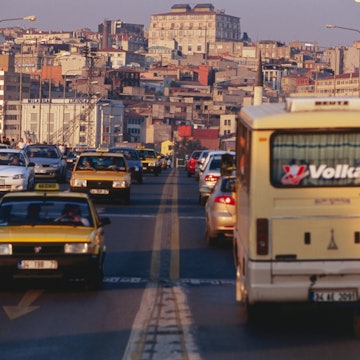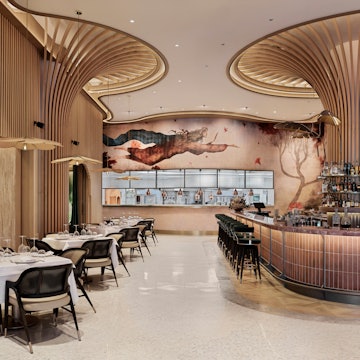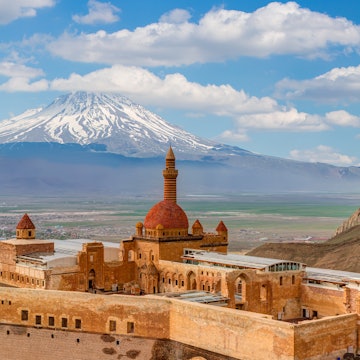

The pedestrianized Istiklal Caddesi shopping and entertainment area with a restored vintage tram © eFesenko / Shutterstock
Sprawling over more than 2000 sq miles and heaving with upwards of 15 million residents, Istanbul is massive – and often mired in traffic. But this megacity is also crisscrossed by a large array of reasonably well-integrated transport options.
Even better news for visitors is that most major sights, historic neighborhoods and other key attractions are located within a relatively compact central area of the city, and you can cover it with a combination of walking and rides on the tram, metro or ferry, all of which are straightforward to use.
Explore neighborhoods on the tram
Of Istanbul’s four modern tram lines, the one most useful to visitors is the T1, which starts near the Kabataş ferry terminal and runs across the Galata Bridge and past the sights of Sultanahmet. There’s also a tram (T5) alongside the Golden Horn that stops in the colorful neighborhoods of Fener, Balat and Eyüp, and a tram (T3) that winds through the Kadıköy district on Istanbul’s Asian side.
Two funicular lines, one between Karaköy and Tünel Square and the other between Kabataş and Taksim Square, connect the T1 tram with the pedestrianized shopping and entertainment area around İstiklal Caddesi, saving a steep uphill hike. From the Eyüp stop of the T1, a cable car goes up to the popular Pierre Loti café and viewing area.
Move quickly across the city on the metro and the marmaray
Istanbul’s ever-expanding metro lines extend for more than 80 miles, connecting new parts of the city as it grows. Most visitors probably won’t need to use any lines other than the M2 between Hacıosman and Yenikapı, which passes through the business and shopping districts around Levent, Taksim Square and Şişhane in Beyoğlu, and across the Golden Horn. A separate underground rail system, the Marmaray, connects with the metro at Yenikapı and goes under the Bosphorus in a tunnel to the Asian side.

Enjoy incredible views from the ferry
The stunning views make a ride on one of Istanbul’s ferries a tourist attraction in itself. Boats regularly cross the Bosphorus between Eminönü, Karaköy, Kabataş and Beşiktaş on the European side and Kadıköy and Üsküdar on the Asian side. Ferries also run approximately hourly along the Golden Horn, every couple of hours to the Princes’ Islands and more occasionally up and down the Bosphorus.
Hang out with the locals on a dolmuş or minibus
True to its name, which means “filled” in Turkish, this type of shared transport only sets off once it is full of passengers. In Istanbul, a dolmuş is typically a yellow van with a few rows of seats that goes back and forth between two destinations. They can be handy for getting from Taksim Square to Beşiktaş, or over to Kadıköy once the ferries stop running late at night.
Minibuses usually ply longer routes and run on a set schedule. Both types of vehicles generally have a sign in the front window indicating their destination. Minibuses pick up and drop off at designated stops along the way, while dolmuş passengers tell the driver where they want to get out. Another important difference is that a dolmuş driver will only take cash, not an Istanbulkart or token, for the fare. If you’re on a dolmuş, don’t be surprised if the people sitting behind you hand you a few Turkish lira – you’re expected to pass it up to the driver for them and pass any change back.

The bus is a cheap (but slow) way to travel beyond the city
A web of bus lines covers the city, but it can be hard for visitors to figure out which one goes where they might need. A tunnel under Taksim Square and a parking lot in Eminönü near the ferry docks are two main central bus hubs. And, of course, buses are subject to Istanbul’s notorious traffic. Six metrobus lines operate in their own highway lanes but primarily serve farther-flung residential and business areas.
Be careful where you hail a taxi
Istanbul’s taxi drivers have a bad reputation for trying to pad fares, refusing to pick up passengers and other bad behavior, especially when it comes to foreign visitors. It’s best to get a cab from a stand or hotel, or by using an app like Uber or BiTaksi. Cab drivers have vociferously objected to Uber, which as a result only operates using regular yellow or turquoise taxis.
Driving in Istanbul isn't worth the drama
Given Istanbul’s heavy traffic, aggressive drivers and perpetual construction, you’re better off not using a car to get around the city. If you do need a vehicle for an excursion farther afield, most major international rental agencies have offices around Taksim Square.
Bike rides are better away from the road
Bicycles are little used as daily transportation in Istanbul, and given the lack of bike lanes and driver awareness of cyclists, it’s not recommended as a way of getting around. There are, however, pleasant places for a recreational ride, particularly alongside the Bosphorus and on the Marmara shoreline on both the European and Asian sides of the city. The app-based municipal bike rental system İSBİKE has stations along all those coasts. The Princes’ Islands are a popular spot to ride bikes too. Marti brand electric scooters are increasingly ubiquitous as well.

How to use the Istanbulkart (Istanbul Card)
A refillable Istanbulkart is usable on all forms of public transport and gives a 30% discount on fares, plus the convenience of not buying single tickets, making it worth the occasional hassle to procure one. The cards are sold from yellow and blue vending machines at many (but not all) metro and tram stops – look for the “Biletmatik” sign. One card costs 50TL, not including any credit. You can add credit using the same machines. There’s also an app, but it can be hard to navigate if you don't speak Turkish.
Tip for using Istanbulkart: You can also use your Istanbulkart credit to pay the 1TL fee to use many city-run public toilets.
Accessible transportation in Istanbul
Istanbul poses challenges to travelers with disabilities. The metro, tram and ferry lines are all fairly accessible, but travelers may encounter unexpected steps, gaps or out-of-service elevators, among other impediments.
Transferring between two methods of transport is not always seamless either. Buses are often crowded, though some do have lifts and space for a wheelchair. Some sidewalks have tactile paving and audio crosswalk signals, but the city’s obstacle course of uneven pavement, throngs of pedestrians, poorly signed construction and street-side seating, vendors, advertising and storage can be tricky to navigate even for those without mobility issues.
Click here to download Lonely Planet's free Accessible Travel guide.
















